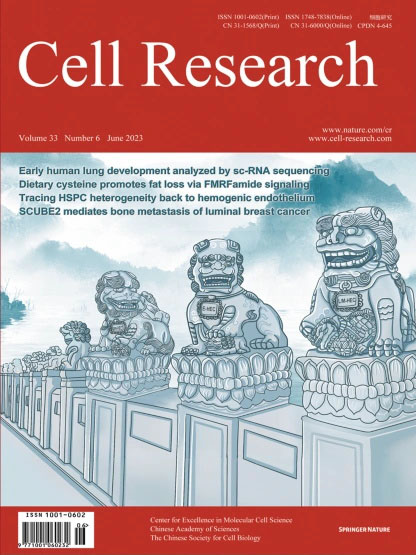
Advanced Search
Submit Manuscript
Advanced Search
Submit Manuscript
Volume 33, No 6, Jun 2023
ISSN: 1001-0602
EISSN: 1748-7838 2018
impact factor 17.848*
(Clarivate Analytics, 2019)
Volume 33 Issue 6, June 2023: 421-433 |
Single-cell RNA sequencing reveals the developmental program underlying proximal–distal patterning of the human lung at the embryonic stage
Shangtao Cao1,2,3,4,†,* , Huijian Feng3,5,6,† , Hongyan Yi2,7,† , Mengjie Pan1,† , Lihui Lin5,8,† , Yao Santo Zhang3,† , Ziyu Feng1,4,† , Weifang Liang3 , Baomei Cai1 , Qi Li2,9 , Zhi Xiong3,5,8 , Qingmei Shen1 , Minjing Ke3,5,6 , Xing Zhao2,9 , Huilin Chen3,5,6 , Qina He2,9 , Mingwei Min1 , Quanyou Cai3,5,6 , He Liu3,4 , Jie Wang5,8 , Duanqing Pei7,10,* , Jiekai Chen3,5,6,8,10,* , Yanlin Ma2,9,*
1Guangzhou Laboratory, Guangzhou, Guangdong, ChinaThe lung is the primary respiratory organ in human, in which the proximal airway and the distal alveoli are responsible for air conduction and gas exchange, respectively. However, the regulation of proximal–distal patterning at the embryonic stage of human lung development is largely unknown. Here we investigated the early lung development of human embryos at weeks 4–8 post fertilization (Carnegie stages 12–21) using single-cell RNA sequencing, and obtained a transcriptomic atlas of 169,686 cells. We observed discernible gene expression patterns of proximal and distal epithelia at week 4, upon the initiation of lung organogenesis. Moreover, we identified novel transcriptional regulators of the patterning of proximal (e.g., THRB and EGR3) and distal (e.g., ETV1 and SOX6) epithelia. Further dissection revealed various stromal cell populations, including an early-embryonic BDNF+ population, providing a proximal–distal patterning niche with spatial specificity. In addition, we elucidated the cell fate bifurcation and maturation of airway and vascular smooth muscle progenitor cells at the early stage of lung development. Together, our study expands the scope of human lung developmental biology at early embryonic stages. The discovery of intrinsic transcriptional regulators and novel niche providers deepens the understanding of epithelial proximal–distal patterning in human lung development, opening up new avenues for regenerative medicine.
https://doi.org/10.1038/s41422-023-00802-6